Development of a Table-Top High-Power, High-Stability, High-Harmonic-Generation Extreme-Ultraviolet Laser Source
Abstract
1. Introduction
2. The 515 nm Driving Laser for HHG
2.1. The Driving Laser and Frequency Doubling
2.2. The Spectrum Broadening and Pulse Compression
2.3. The Stability Control by the Point Lock System
3. HHG-EUV Source
3.1. The Generation and Spectrum Measurement of the EUV Light Source
3.2. Harmonic Beam Profile and Power Stability
3.3. Spectral Analysis
4. Conclusions
Author Contributions
Funding
Data Availability Statement
Conflicts of Interest
References
- McPherson, A.; Gibson, G.; Jara, H.; Johann, U.; Luk, T.S.; McIntyre, I.A.; Boyer, K.; Rhodes, C.K. Studies of multiphoton production of vacuum-ultraviolet radiation in the rare gases. J. Opt. Soc. Am. B Opt. Phys. 1987, 4, 595–601. [Google Scholar]
- Chini, M.; Zhao, K.; Chang, Z.H. The generation, characterization and applications of broadband isolated attosecond pulses. Nat. Photonics 2014, 8, 178–186. [Google Scholar] [CrossRef]
- Hentschel, M.; Kienberger, R.; Spielmann, C.; Reider, G.A.; Milosevic, N.; Brabec, T.; Corkum, P.; Heinzmann, U.; Drescher, M.; Krausz, F. Attosecond metrology. Nature 2001, 414, 509–513. [Google Scholar] [CrossRef]
- Paul, P.M.; Toma, E.S.; Breger, P.; Mullot, G.; Augé, F.; Balcou, P.; Muller, H.G.; Agostini, P. Observation of a train of attosecond pulses from high harmonic generation. Science 2001, 292, 1689–1692. [Google Scholar] [CrossRef] [PubMed]
- Corkum, P.B. Plasma perspective on strong field multiphoton ionization. Phys. Rev. Lett. 1993, 71, 1994–1997. [Google Scholar] [CrossRef] [PubMed]
- Lewenstein, M.; Balcou, P.; Ivanov, M.Y.; L’Huillier, A.; Corkum, P.B. Theory of high-harmonic generation by low-frequency laser fields. Phys. Rev. A 1994, 49, 2117–2132. [Google Scholar] [CrossRef]
- Mojarad, N.; Gobrecht, J.; Ekinci, Y. Interference lithography at EUV and soft X-ray wavelengths: Principles, methods, and applications. Microelectron. Eng. 2015, 143, 55–63. [Google Scholar] [CrossRef]
- Takahashi, E.; Nabekawa, Y.; Midorikawa, K. Generation of 10-μJ coherent extreme-ultraviolet light by use of high-order harmonics. Opt. Lett. 2002, 27, 1920–1922. [Google Scholar]
- Klas, R.; Kirsche, A.; Gebhardt, M.; Buldt, J.; Stark, H.; Hädrich, S.; Rothhardt, J.; Limpert, J. Ultra-short-pulse high-average-power megahertz-repetition-rate coherent extreme-ultraviolet light source. PhotoniX 2021, 2, 4. [Google Scholar]
- L’Huillier, A.; Schafer, K.J.; Kulander, K.C. Theoretical aspects of intense field harmonic generation. J. Phys. B At. Mol. Opt. Phys. 1991, 24, 3315–3341. [Google Scholar]
- Loetgering, L.; Witte, S.; Rothhardt, J. Advances in laboratory-scale ptychography using high harmonic sources. Opt Express 2022, 30, 4133–4164. [Google Scholar] [CrossRef]
- Lompre, L.A.; L’Huillier, A.; Ferray, M.; Monot, P.; Mainfray, G.; Manus, C. High-order harmonic generation in xenon: Intensity and propagation effects. J. Opt. Soc. Am. B Opt. Phys. 1990, 7, 754–761. [Google Scholar]
- Comby, A.; Bloch, E.; Beauvarlet, S.; Rajak, D.; Beaulieu, S.; Descamps, D.; Gonzalez, A.; Guichard, F.; Petit, S.; Zaouter, Y.; et al. Bright, polarization-tunable high repetition rate extreme ultraviolet beamline for coincidence electron-ion imaging. J. Phys. B-At. Mol. Opt. Phys. 2020, 53, 234003. [Google Scholar]
- Hädrich, S.; Klenke, A.; Rothhardt, J.; Krebs, M.; Hoffmann, A.; Pronin, O.; Pervak, V.; Limpert, J.; Tünermann, A. High photon flux table-top coherent extreme-ultraviolet source. Nat. Photonics 2014, 8, 779–783. [Google Scholar]
- Comby, A.; Descamps, D.; Beauvarlet, S.; Gonzalez, A.; Guichard, F.; Petit, S.; Zaouter, Y.; Mairesse, Y. Cascaded harmonic generation from a fiber laser: A milliwatt XUV source. Opt. Express 2019, 27, 20383–20396. [Google Scholar] [CrossRef]
- Wang, H.; Xu, Y.M.; Ulonska, S.; Robinson, J.S.; Ranitovic, P.; Kaindl, R.A. Bright high-repetition-rate source of narrowband extreme-ultraviolet harmonics beyond 22 eV. Nat. Commun. 2015, 6, 7459. [Google Scholar] [CrossRef]
- Willner, A.; Tavella, F.; Yeung, M.; Dzelzainis, T.; Kamperidis, C.; Bakarezos, M.; Adams, D.; Schulz, M.; Riedel, R.; Hoffmann, M.C.; et al. Coherent Control of High Harmonic Generation via Dual-Gas Multijet Arrays. Phys. Rev. Lett. 2011, 107, 175002. [Google Scholar] [CrossRef] [PubMed]
- Porat, G.; Heyl, C.M.; Schoun, S.B.; Benko, C.; Dörre, N.; Corwin, K.L.; Ye, J. Phase-matched extreme-ultraviolet frequency-comb generation. Nat. Photonics 2018, 12, 387–391. [Google Scholar] [CrossRef]
- Shan, B.; Chang, Z.H. Dramatic extension of the high-order harmonic cutoff by using a long-wavelength driving field. Phys. Rev. A 2002, 65, 011804. [Google Scholar] [CrossRef]
- Li, J.; Lu, J.; Chew, A.; Han, S.; Li, J.; Wu, Y.; Wang, H.; Ghimire, S.; Chang, Z. Attosecond science based on high harmonic generation from gases and solids. Nat. Commun. 2020, 11, 2748. [Google Scholar] [CrossRef]
- Yao, Z.Z.; van Velthoven, C.T.J.; Nguyen, T.N.; Goldy, J.; Sedeno-Cortes, A.E.; Baftizadeh, F.; Bertagnolli, D.; Casper, T.; Chiang, M.G.; Crichton, K.; et al. A taxonomy of transcriptomic cell types across the isocortex and hippocampal formation. Cell 2021, 184, 3222–3241. [Google Scholar] [CrossRef]
- Künzel, S.; Williams, G.O.; Boutu, W.; Galtier, E.; Barbrel, B.; Lee, H.J.; Nagler, B.; Zastrau, U.; Dovillaire, G.; Lee, R.W.; et al. Shot-to-shot intensity and wavefront stability of high-harmonic generation. Appl. Opt. 2015, 54, 4745–4749. [Google Scholar] [CrossRef] [PubMed]
- Shiner, A.D.; Trallero-Herrero, C.; Kajumba, N.; Bandulet, H.C.; Comtois, D.; Légaré, F.; Giguère, M.; Kieffer, J.C.; Corkum, P.B.; Villeneuve, D.M. Wavelength Scaling of High Harmonic Generation Efficiency. Phys. Rev. Lett. 2009, 103, 073902. [Google Scholar] [CrossRef] [PubMed]
- Tate, J.; Auguste, T.; Muller, H.G.; Salières, P.; Agostini, P.; DiMauro, L.F. Scaling of wave-packet dynamics in an intense midinfrared field. Phys. Rev. Lett. 2007, 98, 013901. [Google Scholar] [CrossRef]
- Klas, R.; Eschen, W.; Kirsche, A.; Rothhardt, J.; Limpert, J. Generation of coherent broadband high photon flux continua in the XUV with a sub-two-cycle fiber laser. Opt. Express 2020, 28, 6188–6196. [Google Scholar] [CrossRef]
- Brahms, C.; Travers, J.C. Efficient and compact source of tuneable ultrafast deep ultraviolet laser pulses at 50 kHz repetition rate. Opt. Lett. 2023, 48, 151–154. [Google Scholar] [CrossRef]
- Marcatili, E.A.J.; Schmeltzer, R.A. Hollow Metallic and Dielectric Waveguides for Long Distance Optical Transmission and Lasers. Bell Syst. Tech. J. 1964, 43, 1783–1809. [Google Scholar] [CrossRef]
- Li, J.; Li, K.; Zhang, X.S.; Popmintchev, D.; Xu, H.; Wang, Y.T.; Li, R.X.; Zhang, G.Y.; Tang, J.Y.; Niu, J.; et al. Highly efficient and aberration-free off-plane grating spectrometer and monochromator for EUV-soft X-ray applications. Light-Sci. Appl. 2024, 13, 12. [Google Scholar] [CrossRef] [PubMed]
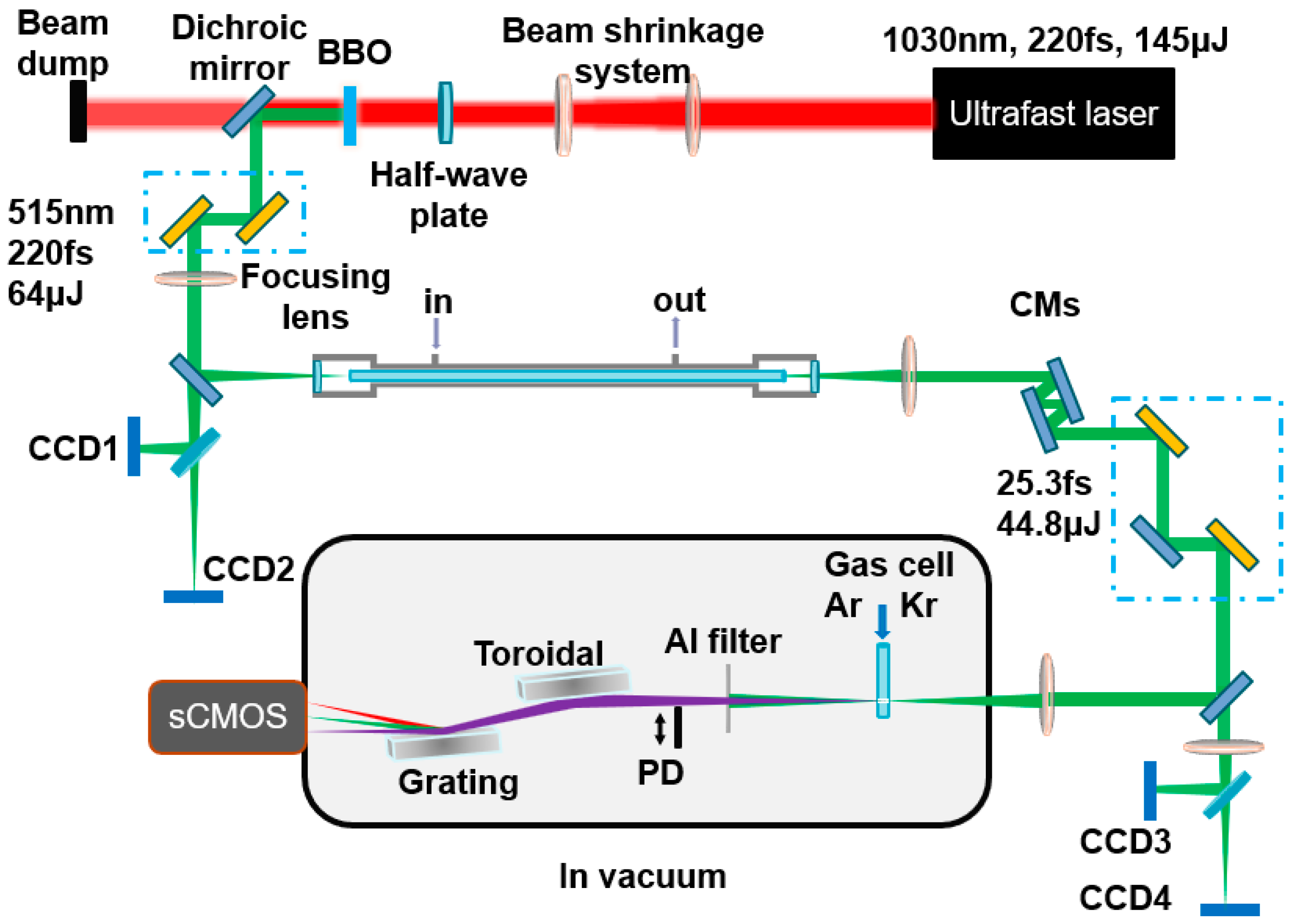
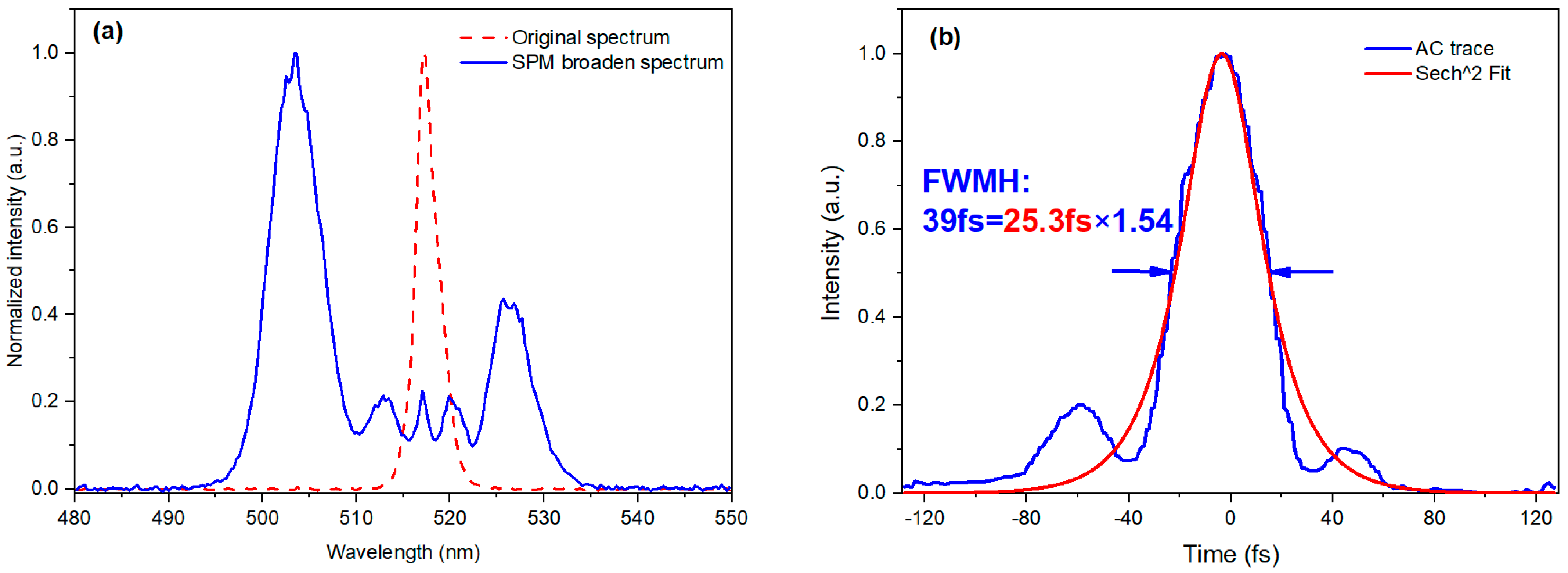
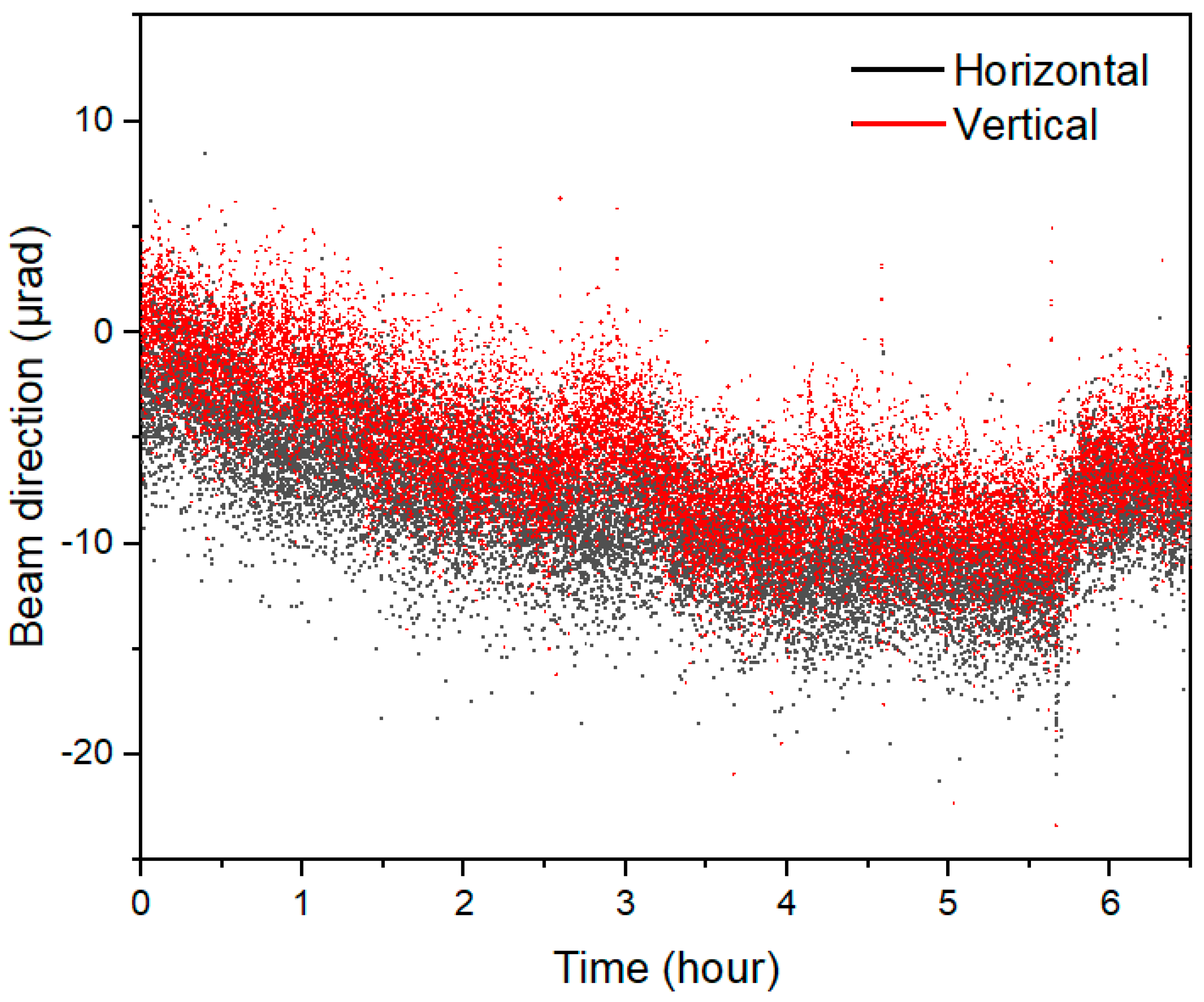
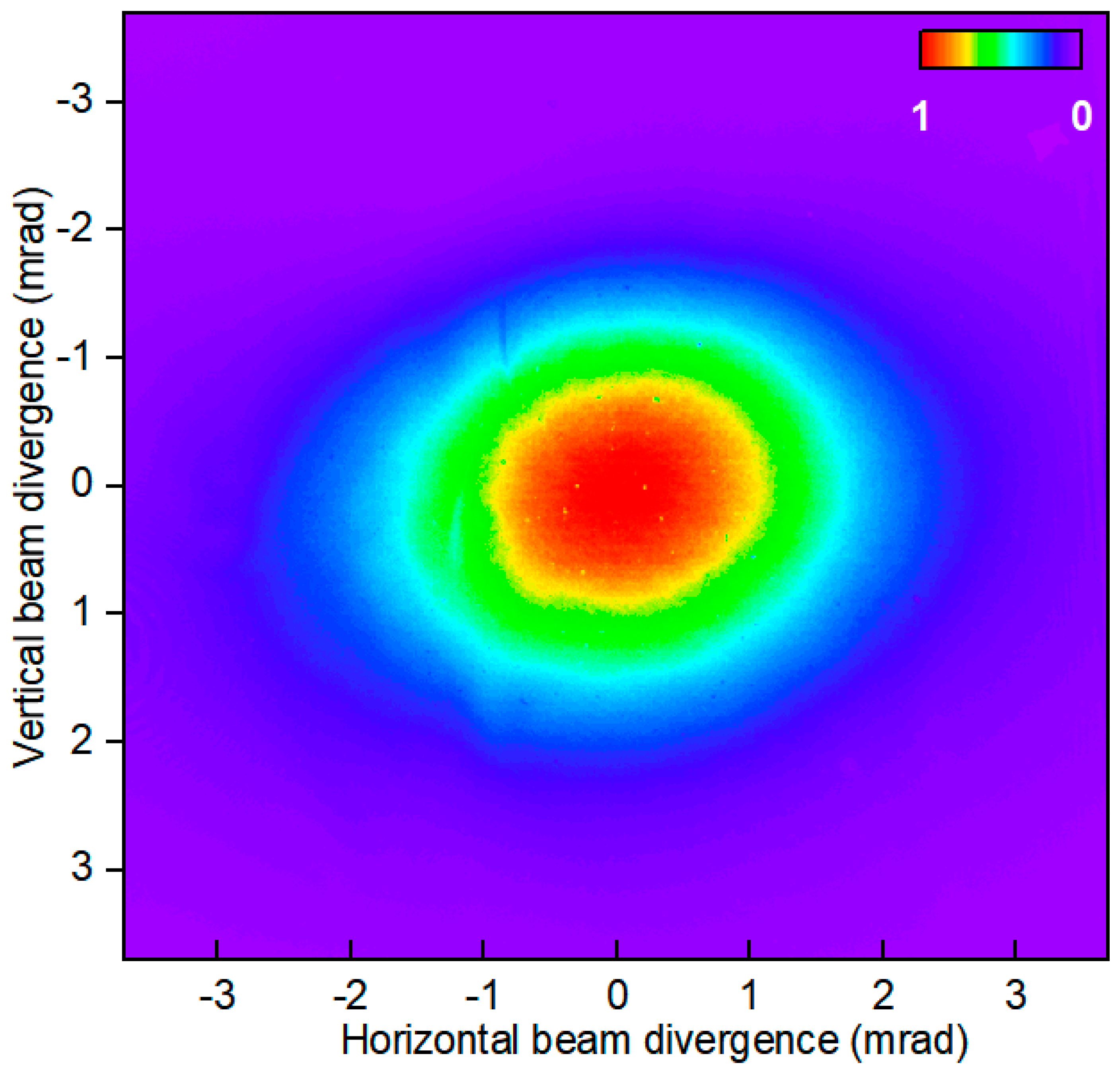
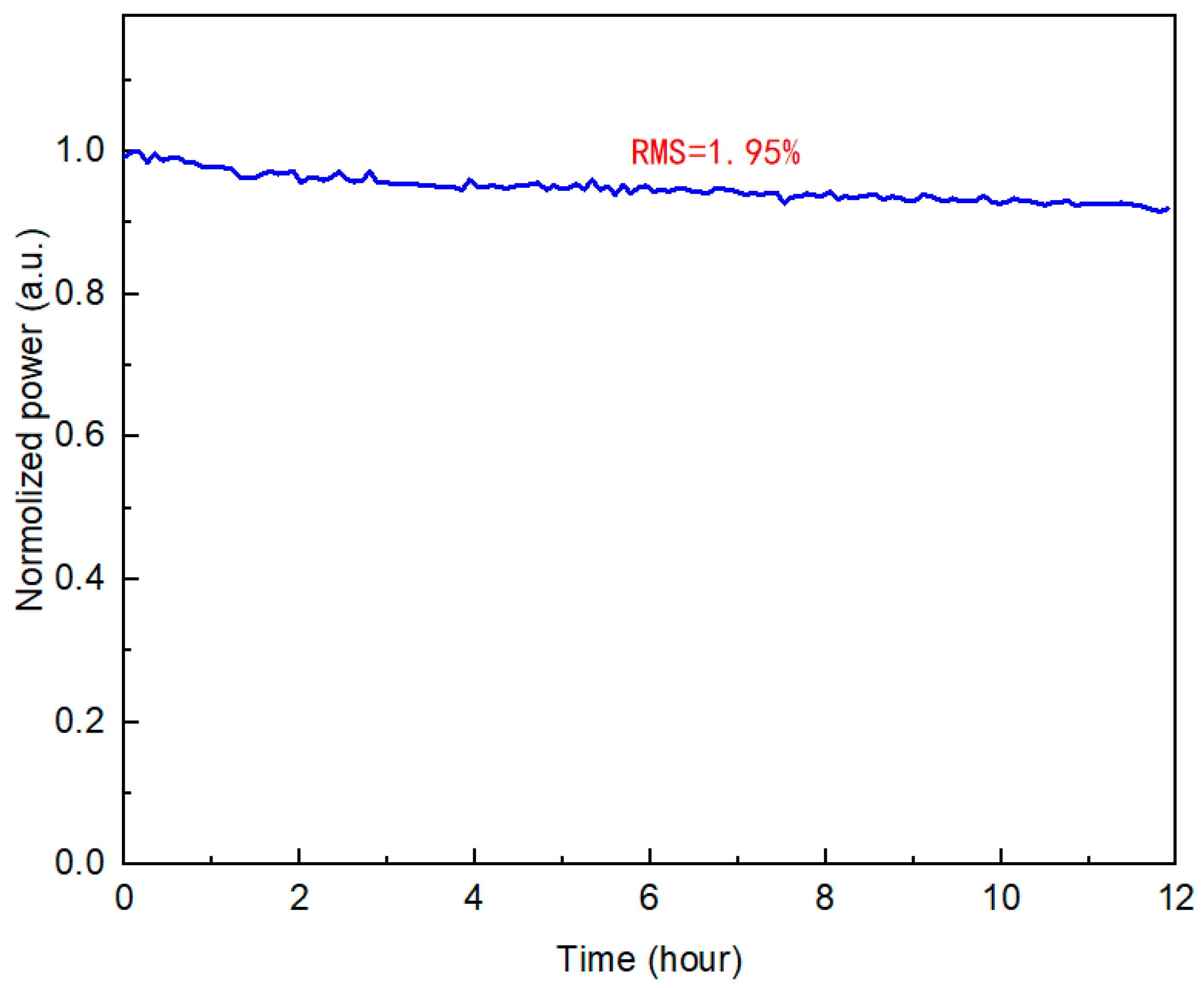

Disclaimer/Publisher’s Note: The statements, opinions and data contained in all publications are solely those of the individual author(s) and contributor(s) and not of MDPI and/or the editor(s). MDPI and/or the editor(s) disclaim responsibility for any injury to people or property resulting from any ideas, methods, instructions or products referred to in the content. |
© 2025 by the authors. Licensee MDPI, Basel, Switzerland. This article is an open access article distributed under the terms and conditions of the Creative Commons Attribution (CC BY) license (https://creativecommons.org/licenses/by/4.0/).
Share and Cite
Li, R.; Xu, H.; Li, K.; Zhang, G.; Niu, J.; Tang, J.; Xu, Z.; Xiao, Y.; Guo, X.; Hu, J.; et al. Development of a Table-Top High-Power, High-Stability, High-Harmonic-Generation Extreme-Ultraviolet Laser Source. Photonics 2025, 12, 942. https://doi.org/10.3390/photonics12090942
Li R, Xu H, Li K, Zhang G, Niu J, Tang J, Xu Z, Xiao Y, Guo X, Hu J, et al. Development of a Table-Top High-Power, High-Stability, High-Harmonic-Generation Extreme-Ultraviolet Laser Source. Photonics. 2025; 12(9):942. https://doi.org/10.3390/photonics12090942
Chicago/Turabian StyleLi, Ruixuan, Hao Xu, Kui Li, Guangyin Zhang, Jin Niu, Jiyue Tang, Zhengkang Xu, Yuwei Xiao, Xiran Guo, Jinze Hu, and et al. 2025. "Development of a Table-Top High-Power, High-Stability, High-Harmonic-Generation Extreme-Ultraviolet Laser Source" Photonics 12, no. 9: 942. https://doi.org/10.3390/photonics12090942
APA StyleLi, R., Xu, H., Li, K., Zhang, G., Niu, J., Tang, J., Xu, Z., Xiao, Y., Guo, X., Hu, J., Wang, Y., Ma, Y., Guo, G., Liao, L., Ke, C., Li, J., & Fan, Z. (2025). Development of a Table-Top High-Power, High-Stability, High-Harmonic-Generation Extreme-Ultraviolet Laser Source. Photonics, 12(9), 942. https://doi.org/10.3390/photonics12090942



